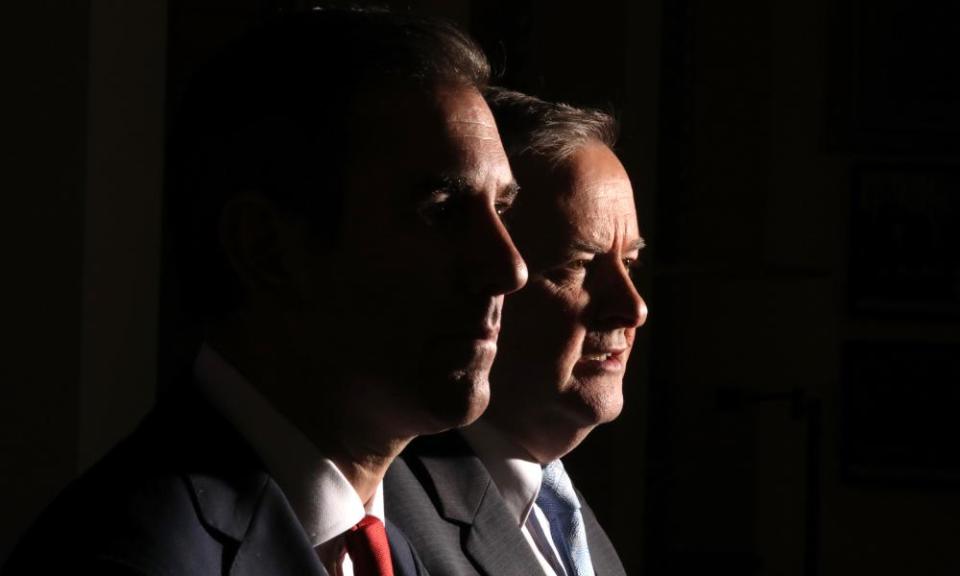Labor’s capitulation on tax cuts shows the price it will pay to win power

The Labor party seems to have decided to shrink its policies to the very few things it believes are politically advantageous as it looks to the next election.
In doing so it has thrown its support behind the most inequitable tax cuts in Australia’s history, effectively putting an end to progressive taxation in this country.
Oh, the things you do when you want to win so badly that you have forgotten why exactly you want to win so badly.
Related: How fast is Australia’s economy running? Fiscal and monetary stimulus certainly helps | Greg Jericho
This week the ALP announced it had dumped its negative gearing and capital gains tax policies (no real shock – it hadn’t mentioned them since the 2019 election) and said it would now support the legislated stage three-tax cuts to come into force in 2024-25.
Both decisions are bad policies that favour the wealthy. But the decision to support the stage-three tax cuts means the ALP now believes increasing inequality is a price it must pay if it wants to win government.
What is the point of a progressive party if not to reduce inequality, you might ask. To be honest, at this point I don’t know.
Clearly the ALP wants to fight on the issue of corruption and rorts – to wit the party’s announcement on Monday of a federal Icac – and on the botched vaccine rollout.
It may work. It will still leave Australia less equal.
It is also unnecessary because it is not good politics.
Essentially the stage-three tax cuts are about flattening the income tax rate to 30% for everyone earning between $45,000 and $200,000.
Some eight years ago (just before Guardian Australia began) I wrote of the superannuation debate at the time that it was clear to me that what it was really about was bringing in a flat income tax.
What had once been the policy of libertarian cranks was then starting to be accepted in the Liberal party. And that battle was won on Monday with the ALP’s not untypical capitulation:
Click here if you cannot view the graph
The reason this remains bad politics is because of who benefits. Someone on $200,000 will get a tax cut of just over $9,000 a year compared with $275 for someone on the median income of about $60,000:
Click here if you cannot see the graph
Now, sure, those who earn more get bigger nominal tax cuts, but even when we look in percentage terms the cuts remain woefully inequitable – and easy to dismiss politically if a party had any wit.
The cuts are actually made up of three parts. The first part is to cut the marginal rate paid by those earning between $45,000 and $120,000 from 32.5% to 30%.
This most benefits those earning $120,000. Those earning above that amount do benefit because they pay less tax on the first $120,000 they earn, but it reduces as the amount they earn increases.
This is the easiest part of the tax cuts to keep for the ALP. The cut is not needed but, given that those earning median to average incomes do actually get a tax cut of about 1%, politically that’s a tough thing to fight.
But there’s no excuse for supporting the second and third parts.
The second part is the lowering of the marginal tax rate for those earning between $120,000 and $180,000, from 37% to 30%.
This flattening of the rate gives no benefit to anyone earning less than $120,000 and provides by itself a 2.3% cut for someone on $180,000. And that is on top of the 1% cut they already have got from the lowering of the 32.5% rate.
But the cuts don’t end here. Those earning between $180,000 and $200,000 will have their top marginal tax rate cut from 45% to 30%:
Click here if you can’t see the graph
That delivers someone on $200,000 an extra 1.5% cut on top of the 3% they already have from the other two stages.
And yes, this is now ALP policy.
Madness.
But what about “aspiration”?
Let’s consider two common occupations (especially for women), a general nurse and a primary school teacher.
In 2018-19, according to the Australian Taxation Office, the median income for a nurse was $69,391 and $73,730 for a primary school teacher.
If we generously give them a 2.5% annual raise, the teacher’s median income will not reach $120,000 until 2038-39 and the nurse will not get there until 2040-41:
Click here if you cannot see the graph
Someone on the median taxable income in 2018-19 of $59,9812 won’t get there till 2046-47.
A primary school teacher won’t be expected to earn $180,000 till 2055-56. At which point, I suspect aspiration might have long departed.
Back in 2007 Kevin Rudd also mimicked the Liberal party’s tax cuts but he cleverly opted out of the top-end cut and spent it on education. Today’s ALP should do the same and spend it on something political advantageous, like aged care.
The stage-three tax cuts are terrible policy and not even good politics, but they are alas, our future.
Greg Jericho writes on economics for Guardian Australia

 Yahoo Finance
Yahoo Finance 